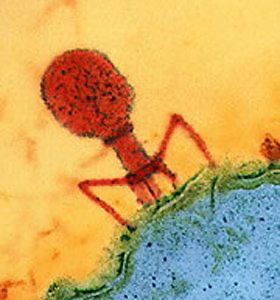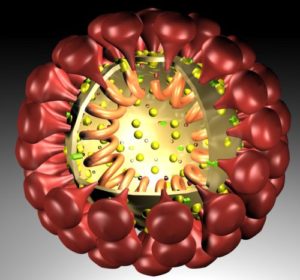 Only a very small percentage of the world’s microbes have been discovered, and even less of the much more plentiful and diverse viruses. So, it is not surprising that many dramatic new viruses have recently been found that alter our understanding of evolution. The giant Pandora viruses and many new unique ocean phages have brought forth questions about the validity of the current three-limbed diagram of the tree of life (archaea, bacteria, eukarya). With viruses and virus like particles constantly transferring genetic material between all cells, including bacteria, plants and animals, the current “tree of life” may not be correct. In fact, viruses might be a critical part of the tree in all phases, they might represent a distinct fourth branch, or the entire tree concept might be wrong. But, the story has become even more complex with the new discoveries of many different types of virus like particles that also ubiquitously transfer genetic material between cells of all types and also exhibit complex behavior. This post will discuss the new findings that demonstrate the great importance of virus and virus like particles in evolution.
Only a very small percentage of the world’s microbes have been discovered, and even less of the much more plentiful and diverse viruses. So, it is not surprising that many dramatic new viruses have recently been found that alter our understanding of evolution. The giant Pandora viruses and many new unique ocean phages have brought forth questions about the validity of the current three-limbed diagram of the tree of life (archaea, bacteria, eukarya). With viruses and virus like particles constantly transferring genetic material between all cells, including bacteria, plants and animals, the current “tree of life” may not be correct. In fact, viruses might be a critical part of the tree in all phases, they might represent a distinct fourth branch, or the entire tree concept might be wrong. But, the story has become even more complex with the new discoveries of many different types of virus like particles that also ubiquitously transfer genetic material between cells of all types and also exhibit complex behavior. This post will discuss the new findings that demonstrate the great importance of virus and virus like particles in evolution.
Viruses in Human Genome
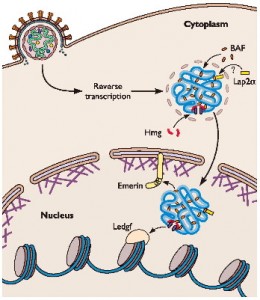 Invasion by virus DNA into the human genome is far greater than anyone suspected. This process has dramatically affected evolution and continues now. The most well known viruses that place their DNA in human cells are called retroviruses, HIV being the most famous. Retrovirus DNA make up approximately 10% of all human DNA, which is six times more than the total amount of DNA in human genes (the human genome is 1.5% of the DNA – see previous post). Retroviruses living in human genes can be as old as a million years.
Invasion by virus DNA into the human genome is far greater than anyone suspected. This process has dramatically affected evolution and continues now. The most well known viruses that place their DNA in human cells are called retroviruses, HIV being the most famous. Retrovirus DNA make up approximately 10% of all human DNA, which is six times more than the total amount of DNA in human genes (the human genome is 1.5% of the DNA – see previous post). Retroviruses living in human genes can be as old as a million years.
Previously, most DNA has been labeled “junk” implying that it has no use in the human cell. But, the 10 year long study ENCODE (encyclopedia of DNA elements) shows that at least 20% of DNA are active in regulation of genes, and possibly as much as 50%. We must, also, remember that another 50% of human DNA consist of “jumping genes,” virus-like DNA particles with the ability to move around in the DNA. Jumping genes can represent an entire section of a protein, which can fuel evolution.
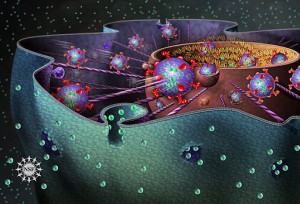 Some of the retroviruses in DNA are able to live in the cell for generations and then re emerge as independent viruses. They can also re combine and alter their DNA emerging as a new type of virus. Viruses in the bacteria genome allows some bacteria to “create” their own viruses at will to send against enemies. (see post Virus Intelligence Update)
Some of the retroviruses in DNA are able to live in the cell for generations and then re emerge as independent viruses. They can also re combine and alter their DNA emerging as a new type of virus. Viruses in the bacteria genome allows some bacteria to “create” their own viruses at will to send against enemies. (see post Virus Intelligence Update)
Human cells attempt to control the effects of the viruses that are embedded in human DNA with “restriction factors”. Human cells, also, mutate their membrane receptor molecules to avoid these virus effects. When one species mutates to avoid the embedded viruses, other species that have not specifically mutated to avoid them can still be affected. An example of this process involves a retrovirus from mice that infects primates and bears causing leukemia. Therefore, a virus living harmlessly in one creature can infect another with very negative effects.
Virus signals from the inserted DNA send messages that can affect RNA transcription and RNA alternative splicing. They can become promotors and enhancers of human DNA function, which is now known to be the major way that diseases occur in humans. Many cancers are caused by retrovirus DNA.
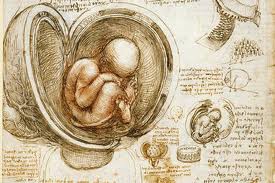 Proteins from virus DNA have also become critical for human function. The production of salivary amylase is controlled by virus DNA. (see previous post Virus Intelligence Update). This virus aided evolution by allowing humans to eat starch. Another retrovirus is critical for the functioning of stem cells in the fetus. Another has allowed special glycoproteins that are essential for the development of the human placenta. In fact, these virus products alter the mother’s immune system to allow the mother to be tolerant to the fetus and not reject it as a foreign body.
Proteins from virus DNA have also become critical for human function. The production of salivary amylase is controlled by virus DNA. (see previous post Virus Intelligence Update). This virus aided evolution by allowing humans to eat starch. Another retrovirus is critical for the functioning of stem cells in the fetus. Another has allowed special glycoproteins that are essential for the development of the human placenta. In fact, these virus products alter the mother’s immune system to allow the mother to be tolerant to the fetus and not reject it as a foreign body.
Pandora Virus, Mimi & Mega Virus
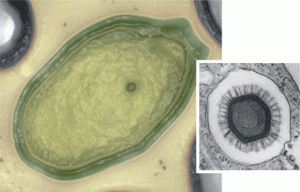
Pandora virus, first described several weeks ago, is as large as bacteria, but does not function like bacteria. That is, it doesn’t divide to reproduce, but, instead, produces hundreds of virus particles at once like other viruses. Pandora virus can’t produce its own proteins and doesn’t produce its own energy. It depends on other cells for both. Unique features include:
- Pandora virus has very different genes than any other known viruses.
- Pandora virus doesn’t have capsid proteins that surrounds many virus’ genes.
- They lack many genes of other known viruses.
- Their DNA appears to be unique and appears to come from a completely new evolutionary path.
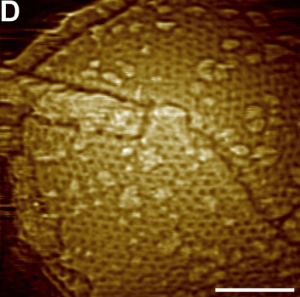
The largest previous viruses are Mimi virus, found in an amoeba ten years ago with half the amount of DNA as the Pandora virus (1.18 million bases with 900 genes) and Megavirus with 1.25 million bases. Because the uniqueness of Mimi virus, Mega virus, and now Pandora virus there may not be three branches of the evolutionary tree but at least four and maybe more.
Many of the most ancient protein folds from all cellular organisms are present in these giant viruses. This is consistent with the fact that viruses were previously larger and more complex and evolved to reduced, more active forms.
Perhaps most significantly, many new virus like particles were discovered colonizing the Pandora virus. Virophages, another class of small phage viruses, inhabit these large viruses, just as phage viruses are focused on bacteria. Even smaller are Transpovirons, a new class of linear creature with 6 to 8 genes that make proteins.
The world of mobile gene elements are now called the “mobilome”. The mobilome of giant viruses have expanded our knowledge and now includes all types of particles that are reproduced in the giant virus DNA. These will be discussed below but include virophages (the first one is called sputnik), transpovirons, self splicing introns and inteins, transposons, linear plasmids, and prophage (A prophage is a phage genome inserted and integrated into the circular bacterial DNA chromosome or existing as an extra chromosomal plasmid).
Viruses and Evolution
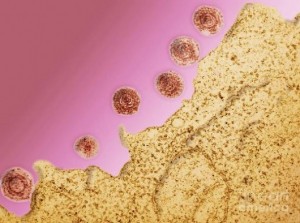 There are three significant new virus findings that promote an entirely new understanding of evolution.
There are three significant new virus findings that promote an entirely new understanding of evolution.
- Recent massive sequencing reveals pervasive horizontal gene transfer (HGT), from viruses and plasmids (a small DNA molecule that is physically separate from, and can replicate independently of, chromosomal DNA within a cell).
- The second recently discovered fact is that of Lamarckian style inheritance needed to defend against viruses – that is epigenetic adaptations to virus attacks. Lamarckian mechanisms include adaptive antivirus immunity from CRISPR in many bacteria and archaea. The CRISPR system has been described in other posts as a way that embedded virus are part of repeated DNA patterns that the cells develop immunity mechanisms to control. The CRISPR immunity, protecting the genome from random DNA, is very efficient with only 0.00001 failure rate. But, this failure rate still allows evolutionary changes.
- The third discovery related to the evolution of microbes is the finding of dedicated mechanisms that stimulate genetic transfer. This includes mechanisms induced by stress allowing increasing mutations to speed up or alter evolution of microbes. The stress induced mutageneis is very well regulated in cells.
Viruses have the greatest genetic diversity. Being the dominant life form on earth they are, therefore, the strongest drivers of evolution.
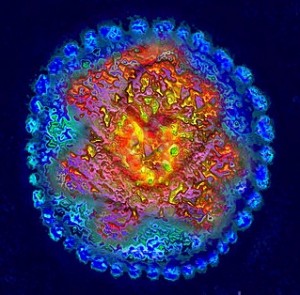 Evolution, it appears, is largely a battle for survival of viruses and virus like particles and their hosts and enemies such as bacteria and animal cells. The three-part tree of life was based on one highly conserved gene for an RNA called 16SRNA. This evolution theory, dogma until recently, is based on 1% of the evidence. Now, it is known that a substantial amount of genes come from horizontal gene transfer, HGT, by virus and virus like particles. It now appears that all genes have been affected by HGT. There are only a small group of genes for translation that appear to be highly conserved and were unaffected by HGT.
Evolution, it appears, is largely a battle for survival of viruses and virus like particles and their hosts and enemies such as bacteria and animal cells. The three-part tree of life was based on one highly conserved gene for an RNA called 16SRNA. This evolution theory, dogma until recently, is based on 1% of the evidence. Now, it is known that a substantial amount of genes come from horizontal gene transfer, HGT, by virus and virus like particles. It now appears that all genes have been affected by HGT. There are only a small group of genes for translation that appear to be highly conserved and were unaffected by HGT.
A totally different view of evolution is called the “dynamic gene universe. In this theory, any given genome is made of many different sources. This model has no tree or vertical evolution. Prokaryotes don’t use sex but use HGT. There are no isolated systems but complex webs of gene exchange.
Did Viruses Develop from Small Particles or from Larger Bacteria?
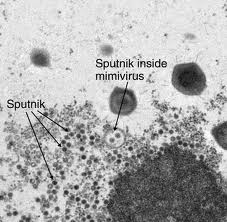 A recent study showed that viruses might have evolved from small genetic elements that occur in all bacteria and are transferred between microbes often in vesicles. These mobile elements are less complex than viruses, and are similar to the pieces of DNA in humans called “jumping genes.”
A recent study showed that viruses might have evolved from small genetic elements that occur in all bacteria and are transferred between microbes often in vesicles. These mobile elements are less complex than viruses, and are similar to the pieces of DNA in humans called “jumping genes.”
These very small pieces of DNA are similar to the tiny viruses called virophages that infect large viruses. It is also possible that large viruses have evolved from bacteria through microbes’ tendency to give up DNA when another larger cell can take over functions (mitochondria gave up genes to eukaryote cells). But, viruses also could have evolved upwards through these very small virophages.
In either case small strands of DNA with specific functions – jumping genes, virophages, virus-like particles in bacteria – all appear to have intelligent functions just like viruses.
Many Virus Like Particles Transferring Genetic Material Affect Evolution
Usually, the virus is considered as the transferring agent, when in fact, there are even smaller creatures that are transferring genetic information among viruses.
- Viruses are pieces of genetic material covered by a protein shell that can manipulate cells to reproduce. They can place themselves into the human genome. In fact 10% of the human DNA are clearly from viruses. This is four times the amount of DNA in all of the human genes (1.5% of the DNA.)
- Phage viruses, the most dominant life form on earth, transfer DNA between bacteria.
Jumping Genes:
- Previous posts have described these strands of DNA (technically called transposable elements or TE) that can sew themselves in and out of the genome. 50% of the DNA in the human chromosomes are jumping genes. There are 2 types.
- One is copy and paste, called retrotransposons, copied in two stages: transcribed from DNA to RNA, then reverse transcribed back to DNA in a different spot. This second step is like a retrovirus, such as HIV, and uses the same enzyme.
 The second is cut and paste, called transposons. There are 3 types: long terminal repeats (LTR) also use the retrovirus enzyme; long interspersed elements, LINE’s, which use a different enzyme; and short interspersed elements, SINEs, transcribed by an RNA enzyme.
The second is cut and paste, called transposons. There are 3 types: long terminal repeats (LTR) also use the retrovirus enzyme; long interspersed elements, LINE’s, which use a different enzyme; and short interspersed elements, SINEs, transcribed by an RNA enzyme.
- Retroviruses are also considered transposable elements like jumping genes.
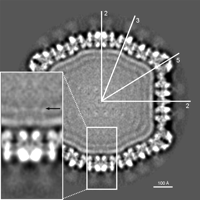 Virophages are very small viruses that colonize and introduce genetic information to larger viruses. The first virophage Sputnik, 74 nm in size, was discovered with the large Mimivirus. More have been recently discovered with the much larger Pandora virus.
Virophages are very small viruses that colonize and introduce genetic information to larger viruses. The first virophage Sputnik, 74 nm in size, was discovered with the large Mimivirus. More have been recently discovered with the much larger Pandora virus.
Transpovirons are a new class of very small creature, which are linear DNA of 7Kb that have 6 to 8 genes making proteins, some of which are the same proteins as in virophages. These transpovirons multiply into large numbers in giant viruses, in virophages, and in amoeba cytoplasm. They can insert themselves anywhere into the genes of the giant virus and the virophage. Each of three giant Mimivirus had multiple transpovirons in their genome.
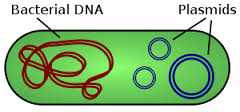 Plasmid is a small piece of DNA that exists separate from the chromosome DNA and is transmitted from one cell to another by horizontal gene transfer HGT. It can function independently inside the cell. These are often circular, double stranded DNA. Plasmids can carry antibiotic resistance genes among.
Plasmid is a small piece of DNA that exists separate from the chromosome DNA and is transmitted from one cell to another by horizontal gene transfer HGT. It can function independently inside the cell. These are often circular, double stranded DNA. Plasmids can carry antibiotic resistance genes among.
Prophage is the DNA of a phage virus that is inserted into the circular bacterial DNA chromosome or as an independent plasmid. This is a latent bacteriophage and may be used by bacteria to “create” bacteria to fight enemies.
Self splicing introns are ribozymes, that is RNA based molecules that function as enzyme catalysts for reactions. These particles are also mobile and are transmitted between cells. These enzymes are active in self-splicing and self-editing of all kinds.
Intein is a piece of a protein that is able to excise itself and join other parts of the protein called exteins. This is protein splicing, not DNA splicing. These have been called protein introns. This is basically a protein particle that acts like a virus or jumping gene.
Insertion sequences (IS) is a short piece of DNA that acts like a jumping gene.
Self-editing alternative RNA transcripts: Alternative RNA transcripts have been described in a previous post as critical to human brain evolution. This self-directed RNA 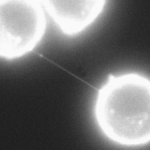 editing, which produces a large number of proteins out of a single gene, is reminiscent of the self-editing of jumping genes.
editing, which produces a large number of proteins out of a single gene, is reminiscent of the self-editing of jumping genes.
Tunneling nanotubes are very small but long tubes between cells where exchanges of genes and proteins can be made.
Exosomes Are A Totally New Category of Cellular Communication of Genetic Material
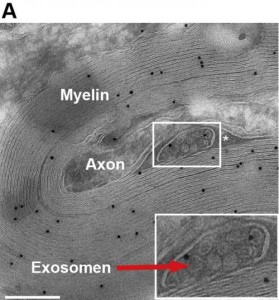 The recent discovery (reported last week) of exosomes communicating genetic information between brain cells is quite shocking. Exosomes are vesicles (small sacs) that behave as a virus and transfer genetic material between brain cells. Neurons interact with glia cells and the glia transfer protein and genetic information in sacs that are critical for neuronal function. Proteins and genetic information are secreted from the cell in small membrane enclosed packages. These tiny nano vesicles are called ‘exosomes’ and are released from oligodendrocytes to be used by neurons for metabolism. Exosomes are fully absorbed and utilized by the neurons. The release is stimulated by glutamate and the material can be used for stressed neurons. Those neurons that receive it are able to better protect themselves with heat shock proteins, glycolytic enzymes and protection from oxidative stress.
The recent discovery (reported last week) of exosomes communicating genetic information between brain cells is quite shocking. Exosomes are vesicles (small sacs) that behave as a virus and transfer genetic material between brain cells. Neurons interact with glia cells and the glia transfer protein and genetic information in sacs that are critical for neuronal function. Proteins and genetic information are secreted from the cell in small membrane enclosed packages. These tiny nano vesicles are called ‘exosomes’ and are released from oligodendrocytes to be used by neurons for metabolism. Exosomes are fully absorbed and utilized by the neurons. The release is stimulated by glutamate and the material can be used for stressed neurons. Those neurons that receive it are able to better protect themselves with heat shock proteins, glycolytic enzymes and protection from oxidative stress.
Viruses and Virus Like Particles in Evolution
There an increasing number of ways that all cells send genetic information back and forth using viruses and virus like particles. If viruses demonstrate intelligent behavior than these much smaller particles do also. Jumping genes, a virus like strand of DNA that makes up 50% of the human DNA, are extremely active in the nucleus and need to be controlled by elaborate mechanisms. Likewise, all of the particles need cellular controls of the effects of their transmitted DNA. Much of the transferred material is extremely useful both in ordinary cellular functioning, but also in evolution. The transferred DNA can be large enough strands to produce an arm of protein, a full protein, an entire function such as antibiotic resistance, or an entire virus.
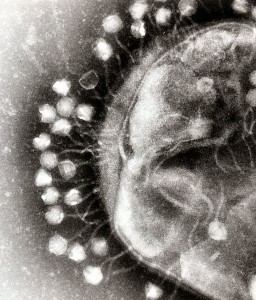 Significantly, cells appear to be able to use these particles to send information back and forth. Recently, bacteria were shown to be able to make their own viruses, at will, to attack enemies. Now, communication of genetic material has been discovered between neurons and glial cells, whereby important capabilities are transmitted from cell to cell.
Significantly, cells appear to be able to use these particles to send information back and forth. Recently, bacteria were shown to be able to make their own viruses, at will, to attack enemies. Now, communication of genetic material has been discovered between neurons and glial cells, whereby important capabilities are transmitted from cell to cell.
Somehow, virus like particles are able to survive and send information between cells, and somehow cells understand how to utilize this information, such as whole bacterial colonies being saved by the transfer of antibiotic resistance genes for present and also, remarkably, for future antibiotic use.
How can very small pieces of DNA exhibit such complex behavior? Where is the direction for intelligent cells using intelligent strands of DNA from virus like particles?
